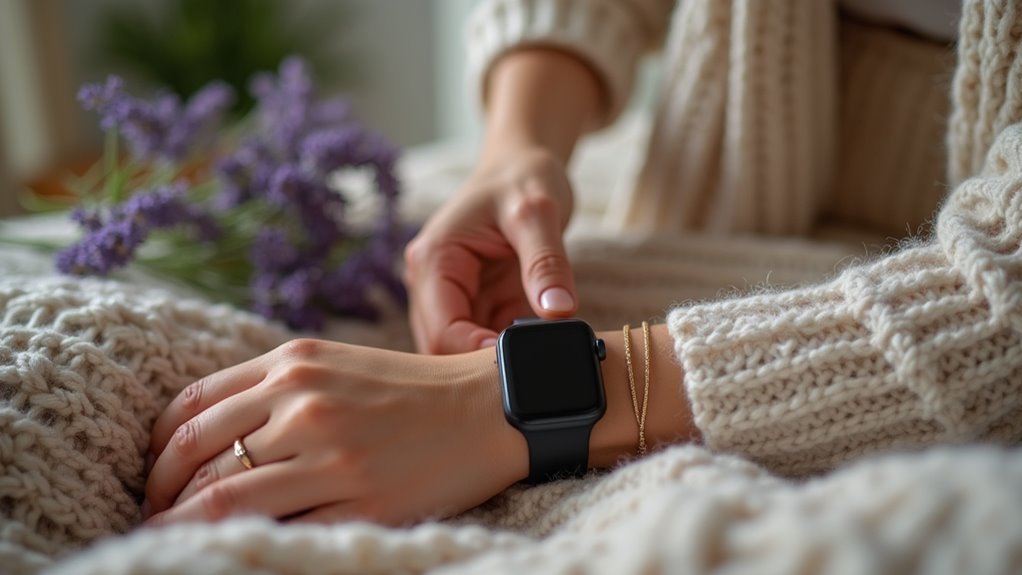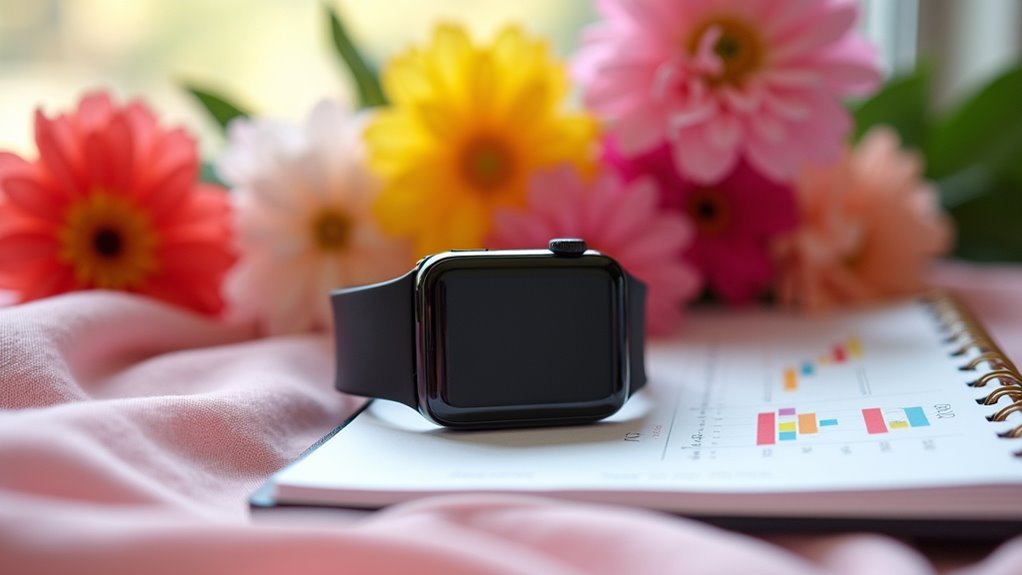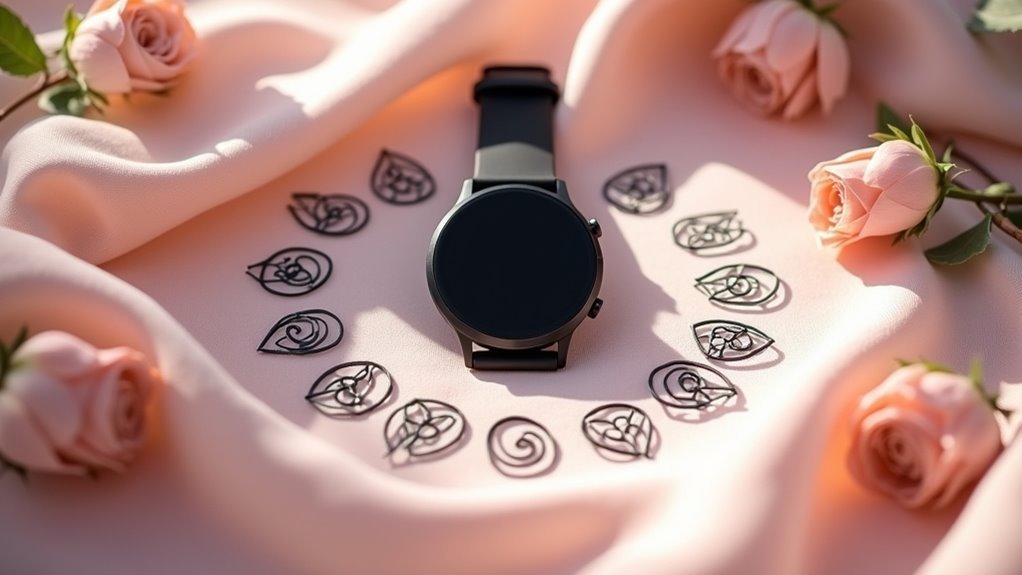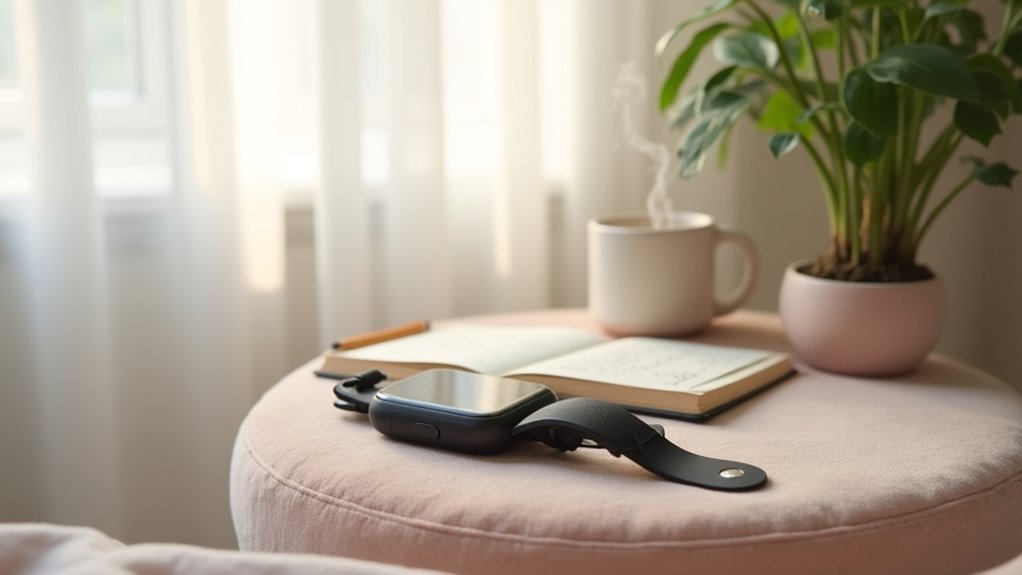You’ll want to choose a breast health wearable that matches your daily routine and comfort needs, focusing on devices with advanced sensor technology and AI-assisted analysis for detecting tissue changes. Wear your device consistently for at least 10 hours daily to guarantee accurate data collection, and maintain proper hygiene by cleaning it regularly with mild soap. Integrate your continuous monitoring data with healthcare provider consultations to transform patterns into actionable insights. These strategies will help you maximize early detection capabilities.
Choose the Right Breast Health Monitoring Device for Your Lifestyle

When selecting a breast health monitoring device, you’ll want to match the technology to your daily routine and personal needs. Consider your activity level first – if you’re highly active, choose devices that track physical movement and integrate with fitness monitoring.
Prioritize comfort and wearability, especially for devices positioned near breast tissue. Look for simple operation if you’re not tech-savvy, and make sure the device fits your budget.
Evaluate features like heart rate monitoring, sleep tracking, and health analytics that provide thorough insights. Battery life should accommodate your schedule, while data security protects your personal information.
For specialized needs, consider devices offering hormonal tracking, fatigue management, or temperature monitoring. These devices can extend beyond basic fitness tracking to provide comprehensive health insights that support overall wellness and recovery.
Choose portable options if you travel frequently, and select home-use devices like wearable ultrasound scanners for convenient monitoring.
Understand Key Features That Enable Early Detection Capabilities
When you’re selecting a breast health wearable, you’ll want to focus on devices equipped with advanced sensor technology that can detect subtle changes in your tissue density and consistency.
Look for systems that offer continuous monitoring capabilities, as they provide ongoing surveillance rather than just periodic snapshots of your breast health. These devices are particularly valuable for high-risk women who need enhanced accessibility when traditional mammography options are limited.
These sophisticated sensors work alongside AI-assisted analysis to distinguish between normal tissue patterns and potentially suspicious anomalies, giving you the early detection advantage that could save your life.
Advanced Sensor Technology
Advanced sensor technology forms the backbone of modern breast health wearables, transforming how you can monitor and detect potential health concerns. These cutting-edge devices utilize graphene-based sensors that provide real-time biomarker detection without invasive blood draws. You’ll benefit from AI-integrated systems that match radiologists’ accuracy rates while offering continuous monitoring from home.
| Technology | Capability | Benefit |
|---|---|---|
| Graphene Sensors | Real-time biomarker detection | Non-invasive monitoring |
| AI Integration | Enhanced detection accuracy | Matches radiologist performance |
| Flexible Design | 3D-printed conforming patches | Better body contact |
Your wearable device can alert healthcare providers immediately when abnormalities are detected, dramatically improving response times. This technology enables personalized care through continuous data collection, making early detection more accessible and cost-effective than traditional screening methods. The latest wearable ultrasound devices achieve 8 centimeters depth imaging capability, allowing comprehensive tissue monitoring that rivals traditional medical equipment.
Continuous Monitoring Systems
While traditional breast screenings occur annually or biannually, continuous monitoring systems revolutionize breast health by providing 24/7 surveillance through wearable technology.
These sophisticated devices use non-invasive methods like ultrasound and diffuse optical imaging to track hormonal and hemodynamic changes in real-time.
You’ll benefit from advanced features that make early detection possible:
- Wearable ultrasound scanners integrated into clothing for frequent, discreet imaging
- Near-infrared optical probes that monitor blood flow changes during treatment
- Flexible, portable designs that move with your body throughout daily activities
- Multiple positioning capabilities for thorough breast tissue assessment
These systems complement traditional diagnostics while offering real-time feedback. Wearables offer insights into breast health through tissue monitoring, providing valuable data that helps identify changes and potential concerns.
You’ll receive timely alerts about potential abnormalities, enabling faster interventions and potentially improving survival rates through continuous health surveillance.
Establish a Consistent Daily Wearing Routine for Accurate Data Collection

You’ll maximize your breast health wearable’s effectiveness by wearing it consistently throughout each day, including during sleep when possible.
This steady routine guarantees you’re capturing complete data patterns that help detect subtle changes in your breast health indicators over time. Studies show that adherence rates for wearable devices can reach up to 100%, with most users maintaining 80% adherence or higher when following consistent wearing schedules.
Building simple habits around when you put on, charge, and sync your device will transform sporadic monitoring into reliable, actionable health insights.
Optimal Daily Wear Times
How can you guarantee your breast health wearable collects the most accurate and meaningful data? You’ll need to establish ideal daily wear times that meet research standards. Most studies require at least 10 hours of wear per day across 5 valid days to guarantee reliable analytics for your health monitoring.
Your commitment to consistent wear times directly impacts data quality and your ability to detect meaningful patterns in your breast health metrics:
- You’re taking control of your health journey through dedicated monitoring
- You’re building confidence in your data’s accuracy and reliability
- You’re creating peace of mind through thorough health tracking
- You’re empowering yourself with actionable insights about your body
Research shows that adherence rates for wearable devices can vary significantly from 60% to 100%, making your consistency even more crucial for obtaining reliable health insights.
Remember to wear your device during all waking hours, removing it only for charging or high-risk activities.
Data Consistency Benefits
When you establish a consistent daily wearing routine, your breast health wearable transforms from a simple gadget into a powerful diagnostic tool that delivers clinically meaningful insights.
You’ll enable early detection of health issues through continuous monitoring, making your treatment plans more personalized and effective. Your healthcare provider can monitor you remotely, reducing frequent check-ups while maintaining quality care.
You’ll find yourself more motivated to maintain healthy lifestyle habits when you see consistent data patterns. This reliable information helps your care team coordinate better interventions and identify ideal interaction timing.
When you wear your device consistently, you’re creating extensive health records that integrate seamlessly with electronic systems, ensuring HIPAA-compliant data sharing while supporting more accurate analysis of your breast health trends. Consistent wearing can significantly reduce unnecessary emergency visits by providing your healthcare team with continuous data to better assess your condition remotely.
Routine Building Strategies
Building a sustainable wearing routine requires strategic planning that aligns with your natural daily rhythms and existing habits. Choose a consistent daily time—morning or evening—that enhances compliance and reduces the mental effort of remembering.
Integrate your wearable with existing activities like dressing or exercising for seamless adoption. Set up automated reminders through your companion app to reinforce your schedule and strengthen habit formation. These personalized alerts act as behavioral nudges when routine disruptions occur. Consider that wearable breast health devices can provide real-time monitoring capabilities that complement traditional screening methods.
Key strategies that transform compliance into second nature:
- Morning ritual integration – Pair wearing with coffee or getting dressed
- Evening wind-down routine – Incorporate during bedtime preparations
- Exercise synchronization – Align with workout schedules for ideal data
- Progress visualization – Track wearing patterns to maintain motivation
Learn How to Interpret Your Breast Health Data and Metrics

While wearable devices collect vast amounts of health data, you’ll need to understand what those numbers actually mean for your breast health journey.
Focus on key metrics like activity levels, which correlate with better recovery outcomes during cancer treatment. Monitor your step count to set realistic goals and track progress over time.
Pay attention to sleep quality data, as rest is essential for physical and mental healing. Heart rate variability can reveal stress levels affecting your overall health.
Don’t ignore caloric expenditure tracking, which helps maintain healthy weight management. Use distress monitoring features to identify emotional patterns.
Wearable sensors can provide objective measures that complement your healthcare provider’s assessments and patient-reported outcomes. Remember that longitudinal data provides the most valuable insights, so look for trends rather than daily fluctuations when interpreting your health metrics.
Integrate Your Wearable Data With Healthcare Provider Consultations
You’ll maximize your breast health wearable’s value by actively sharing your data with healthcare providers during consultations.
Don’t wait for your doctor to ask—bring up patterns you’ve noticed in your metrics and discuss what the trends might mean for your health.
This proactive approach helps your provider offer targeted insights and develop more personalized care plans based on your real-world data. The continuous monitoring capabilities of wearable devices provide insights that extend far beyond single office visits, giving your healthcare team a comprehensive view of your health dynamics over time.
Share Data Proactively
When you integrate your wearable data with healthcare provider consultations, you’re joining nearly 80% of women who want their devices to sync with electronic health records for seamless data sharing.
This proactive approach transforms your breast health monitoring from reactive to preventive care.
Your wearable becomes a powerful health ally when you share data consistently. Real-time health information enables more accurate, personalized medical care tailored specifically to your needs.
You’ll be 40% more likely to visit doctors regularly, promoting early interventions and better outcomes. These devices use AI technology to analyze patterns and provide enhanced insights that support more informed healthcare decisions.
Key benefits of proactive data sharing:
- Peace of mind through continuous monitoring and early detection
- Empowerment with real-time feedback about unusual health patterns
- Confidence in HIPAA-compliant secure data transmission
- Control over personalized treatment plans based on your unique data
Discuss Actionable Insights
Since your wearable captures thousands of data points daily, transforming this information into actionable insights requires strategic collaboration with your healthcare provider. You’ll want to discuss longitudinal trends in your physical activity, heart rate, sleep patterns, and symptoms during consultations to inform diagnostic decisions and treatment adjustments.
| Wearable Data Type | Discussion Points |
|---|---|
| Heart Rate Trends | Daily variations and stress responses |
| Activity Levels | Exercise tolerance and energy patterns |
| Sleep Quality | Duration, interruptions, and recovery |
| Symptom Tracking | Pain levels and timing correlations |
| Menstrual Cycle | Hormonal fluctuations and breast changes |
Your provider can identify early warning signs of health deterioration through structured review of these metrics, enabling proactive care adjustments and personalized treatment recommendations. With nearly 80% of women wanting wearables to sync with EHRs, this integration facilitates seamless data sharing and enables your doctor to monitor your health remotely between appointments.
Maximize Battery Life and Device Performance for Continuous Monitoring
Battery optimization directly impacts your breast health wearable’s ability to provide uninterrupted monitoring throughout your daily routine.
You’ll want to implement strategic power management techniques that guarantee consistent data collection without frustrating interruptions.
Essential battery optimization strategies include:
- Enable low power mode when you’re sleeping or during inactive periods to extend monitoring duration
- Use efficient charging habits by charging regularly rather than waiting for complete battery depletion
- Optimize background processes by closing unnecessary apps that drain power unnecessarily
- Monitor battery health regularly to identify potential issues before they disrupt your health tracking
You should also consider activating Bluetooth Low Energy (BLE) settings and implementing shutoff currents during standby periods.
These adjustments help maintain continuous breast health monitoring while maximizing your device’s operational lifespan and performance reliability.
Check battery levels before leaving home to ensure your wearable maintains consistent monitoring capabilities throughout extended periods away from charging sources.
Set Up Personalized Alerts and Notifications for Health Changes
Although effective monitoring forms the foundation of breast health tracking, personalized alerts transform raw data into actionable health insights that can detect changes before they become serious concerns.
Personalized health alerts convert monitoring data into early warning systems that identify potential breast health issues before they escalate.
You’ll want to customize your alert settings based on your individual risk factors and health preferences. Configure notifications for essential sign irregularities, hormonal fluctuations, and thermal pattern changes that could indicate breast abnormalities.
Set up AI-driven alerts that analyze your health patterns using machine learning algorithms. These systems provide predictive analytics and real-time anomaly detection, ensuring you receive immediate notifications when intervention’s needed. Advanced wearables can facilitate early detection of potential breast health issues through continuous monitoring of physiological changes.
Integration with medical apps allows seamless data sharing with healthcare providers, enhancing your personalized care. Combine activity monitoring, sleep tracking, and lifestyle data for thorough health insights that enable proactive decision-making.
Maintain Proper Device Hygiene and Skin Care While Wearing
Proper device hygiene and skin care protocols guarantee your breast health wearable operates effectively while protecting your skin from irritation and infection.
Clean your device regularly with a soft cloth and mild soap to prevent bacterial buildup, then dry it thoroughly to avoid moisture accumulation. Always follow your manufacturer’s specific cleaning guidelines and never share your device with others. Healthcare facilities have demonstrated that wearable technology improves patient care outcomes when proper protocols are followed consistently.
Monitor your skin daily for signs of irritation or allergic reactions. Choose devices made from skin-friendly materials and ascertain comfortable, non-restrictive fitting.
Essential skin protection strategies include:
- Apply barrier cream – Creates protective layer against device friction
- Adjust position regularly – Prevents consistent pressure on same skin area
- Check for redness daily – Early detection prevents severe skin reactions
- Remove device periodically – Allows skin to breathe and recover naturally
Combine Breast Health Tracking With Overall Wellness Monitoring
While breast health tracking provides valuable insights into your specific concerns, integrating this data with thorough wellness monitoring creates a more complete picture of your overall health status.
You’ll benefit from combining breast-specific metrics with extensive health data like sleep patterns, activity levels, and hormonal changes. Devices such as Oura and Evie Rings offer multi-faceted tracking that captures these interconnected health factors.
Tracking sleep, activity, and hormones alongside breast health metrics creates a comprehensive view of your interconnected wellness patterns.
This holistic approach enables you to identify patterns between your breast health and other wellness indicators. You can monitor fatigue levels during treatment, track sleep quality’s impact on recovery, and observe how physical activity affects your overall well-being.
When you integrate this combined data with your healthcare provider’s treatment plans, you’re creating a patient-centered care approach that leads to more effective interventions and better long-term outcomes.
Know When to Seek Medical Attention Based on Wearable Insights
Your wearable device can serve as an early warning system, but recognizing which data patterns warrant medical consultation requires careful attention to specific indicators.
Watch for these concerning patterns that require immediate medical evaluation:
- Persistent unusual fatigue – If your activity levels drop dramatically without explanation and remain low for weeks.
- Chronic sleep disruption – When sleep quality consistently deteriorates despite maintaining good sleep hygiene habits.
- Irregular heart rate patterns – Unexplained spikes, drops, or erratic rhythms that persist beyond normal variations.
- Sudden activity limitations – When you can’t maintain previously normal physical activities without significant discomfort.
Don’t ignore discrepancies between your wearable data and how you’re feeling.
If your device shows normal metrics but you’re experiencing persistent symptoms, seek medical attention promptly. While emerging wearable ultrasound technologies show promise for at-home screening, these devices are still in development and cannot replace traditional medical examinations.
Frequently Asked Questions
Are Breast Health Wearables Covered by Health Insurance Plans?
You’ll find that many health insurance plans cover breast pumps, including some wearable models, under ACA requirements. You’ll typically need a prescription and should check with your plan’s preferred suppliers for coverage details.
Can Breast Implants Interfere With Wearable Breast Health Monitoring Accuracy?
Yes, breast implants can interfere with wearable breast health monitoring accuracy. They may obstruct sensor placement or block signals, reducing sensitivity. You’ll need proper sensor positioning and possibly additional diagnostic tools for ideal monitoring.
What’s the Difference Between Breast Health Wearables and Regular Fitness Trackers?
You’ll find breast health wearables offer specialized menstrual cycle tracking, fertility monitoring, and female-specific health features, while regular fitness trackers focus primarily on basic activity, steps, and general heart rate monitoring.
Are There Any Age Restrictions for Using Breast Health Wearables?
You can use breast health wearables at any adult age since there aren’t FDA age restrictions. They’re most effective during mammography screening years (40+), but you can start earlier for awareness.
Can Men Use Breast Health Wearables for Monitoring Purposes?
You can technically use breast health wearables, but they’re specifically designed for women’s needs. Men rarely require breast cancer screening, so you’d likely find limited utility and support for male monitoring purposes.




Leave a Reply